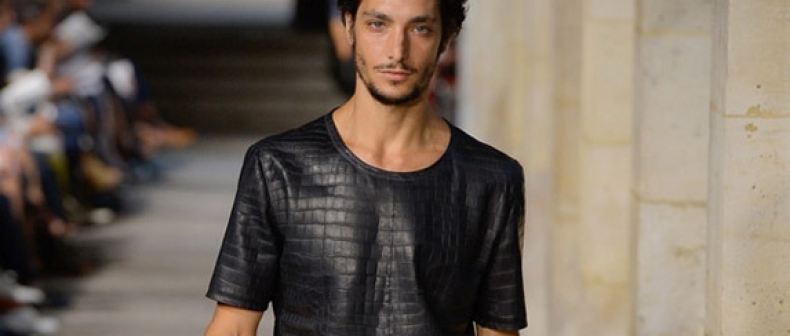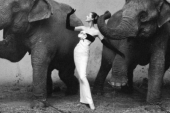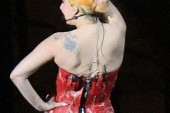
I have too many t-shirts. Most of us do. They’re cheap and easy to wear. They’re comfortable. At the end of a long day, nothing feels better than exchanging your work clothes for a well-loved soft tee. We have t-shirts from ex-girlfriends and boyfriends. When you volunteer, you get one for free. On vacation, only those with the strongest of wills will not come home with a t-shirt souvenir. The t-shirt, adaptable to every cultural shift including post modernity’s pervasive irony, is even in on the joke: “I went to Cancun and all I got was this lousy t-shirt.”
T-shirts gained popularity with the general public after soldiers wore them as underwear during WWII. They’ve never lost the utilitarian nature of their design. The bikers and street toughs who adopted t-shirts as outerwear after the war may have done so because they were affordable and comfortable, but they ended up looking sexy. Once Marlon Brando smouldered in A Streetcar Named Desire, the die was cast. T-shirts became the most ubiquitous garments of the late 20th century, comparable only to jeans.
Both t-shirts and jeans started out as no-frills workwear before spreading throughout the world with America’s economic expansion. T-shirts were the ultimate people’s fashion. Anyone could have one. They weren’t about luxurious materials or fine details; they were about how you wore them and the torso underneath (particularly true for Marlon Brando).
Then a funny thing happened in the 1980’s and 1990’s. High-fashion companies produced t-shirts with the names Calvin Klein or Emilio Armani plastered across the front. Since the materials and cut were not radically different from the t-shirts you buy at the department store, three to a pack, it was never clearer what you were paying for was the label, not the shirt. Clothing brands used to make luxury items from luxury materials. By the end of the century, labels evoking the memory of luxury were enough.
But what if you wanted to produce the most expensive t-shirt ever, whose price floated just below $100,000? Well, first you’d have to ditch the cotton. Replacing it with silk, leather, or alpaca is probably not going to do it. What about crocodile?
For spring/summer 2013, Hermès showed a t-shirt entirely constructed of what they call “chiffon crocodile”. Because crocodile is not the most comfortable material next to the skin, the company attempted to make it as lightweight as possible, probably why they threw “chiffon” in the title. The Awl snapped a picture of the price tag at the Hermès flagship store in New York: the shirt costs $91,500. To put that in perspective, the taxes alone would be about $8,000, more than I paid for a year of university.
I’ll say this in Hermès’s defense: at least they used a rare material to justify the insane price. If you were a member of the 1% (heck, a member of the 0.001%) you would know you couldn’t pick up a similar t-shirt at Old Navy. Crocodile skin is a bit of an ‘it’ material right now for luxury items. Last fall, Mary-Kate and Ashley Olsen released a crocodile backpack with The Row that cost $39,000. Demand for Hermès crocodile bags has been so high that the company invested in a crocodile farm in Australia.
PETA spokesperson Ashley Byrne told Yahoo! Shine, “One of the reasons these products are so cruel is it can take several animals to make one item; it can take three to four crocodiles to make one handbag. It’s absurd to equate this with a luxury product.”
The tale of the crocodile t-shirt is a reversal of the traditional trickle-down theory of trends, best outlined by Miranda Priestly (Meryl Streep) in The Devil Wears Prada. Designers, stylists, and fashion editors decide something is in (like the colour cerulean), feature it in their collections and magazines, then it makes its way down the fashion ladder to chain stores, outlet malls, and sale bins. The contrasting narrative, apparent since Yves Saint Laurent presented his Beatnik collection for Dior in 1958, is bottom-up–rebellious youths create a radical style, usually from what they have laying around the house, which trendsetters and the fashion industry eventually adopt.
Hermès has taken an item everyone has and made it with a material few can afford. It’s the sartorial equivalent of making Kraft Dinner with perfectly aged cheddar, homemade pasta, and organic ingredients. (Actually, some Toronto restaurants probably do this.) And even if they sell only a couple, the crocodile t-shirt has been worth it for Hermès in free advertising. Sure, a lot of the buzz on the Internet was snarky, but it gets the label’s name in the news, and further aligns them in people’s minds with the world of luxury goods.
I’ve recently adapted to spending more money on clothes and accessories, particularly if they will last awhile. Investing in quality items not only helps you feel more professional, but can make economic sense. Why buy fast fashion knockoffs you dispose of each year? But I can picture no scenario in which I’d spend $1,000 on a t-shirt, let alone $100,000. I did a quick Google search and plane tickets to Sydney start at around $2,000. I would much rather take the money, fly to Australia, and see crocodiles alive and in the flesh.
____
Max Mosher writes about style for Toronto Standard. You can follow him on Twitter at @max_mosher_.
For more, follow us on Twitter @TorontoStandard or subscribe to our newsletter.














